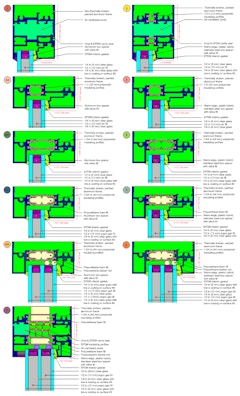
97 results
-
 Closed cavity facades (CCF), a configuration of Double Skin Facade (DSF), consists of a double-glazed unit on the inner layer and single glazing on…
Closed cavity facades (CCF), a configuration of Double Skin Facade (DSF), consists of a double-glazed unit on the inner layer and single glazing on… -

Verifying Thermal Performance
- Paper by Matthew Herman, Mark Walsh,
Architects specify curtain wall thermal performance criteria and usually identify simple modeling software, like THERM, to perform thermal analysis… -

Turning Up the Heat: Back to the Basics with Thermal Performance
- Article by Mic Patterson, PhD, LEED AP+, Executive Editor, SKINS
It’s that time of year as the holidays approach and heating bills climb. Next to moisture control, thermal behavior has occupied the top spot in performance considerations of the facade system for many years now. So how are we doing? Not so hot!
-
The Great Spandrel Glass Debate
- Paper by Richard Green SE PE P.Eng CPEng IntPE APEC Engineer M.ASCE M.IEAust, Principal / Owner
As we change the rules of thermal performance for facades, we are changing the conditions the glass is subject to in shadow boxes and glazed spandrel… -

The Performative Double-Skin
- Paper by Jeffrey Abramson, AIA, LEED AP · Alejandra Menchaca, PhD, LEED AP, WELL AP
Double-Skin Facades (DSF) are well-known to boost the thermal performance of a façade: they can provide extra insulation in the wintertime and lower
-
3D thermal modelling of complex facades
- Paper by Wout Parys · Piet Houthuys
Today’s building enclosures face ever greater demands regarding their thermal performance. In cold climates, the required total U-value of the façade
-
Attention to Overheating in Curtainwall Buildings
- Paper by Yuzhen Zhou NFRC CS, LEED AP, Technical Director at Warmframe Technology
Several years ago, Technoform and the Solar Energy Research Institute of Singapore (SERIS) researched the thermal performance of different aluminum… -

Condensation Study of Windows
- Paper by Ajla Aksamija · Suncica Milosevic · Helen Sanders · Alexandra Blakeslee
This paper discusses a simulation study of different window systems, where heat transfer simulations were performed to investigate thermal
-

Transparent Aerogel Window
- Paper by Bryan Toton, ENV SP
Incorporating a novel, transparent monolithic aerogel into insulated glass units (IGUs) for windows and building enclosures will provide the
-

The Facade and Energy Codes
- Paper by Elliot Glassman,
Ever-increasing performance requirements in the latest version of the energy codes are compelling project teams to consider the thermal performance… -
Unitized Cavity Wall Design and Implementation
- Paper by Dan Bettenhausen, Ph.D., Director of Mechanical Engineering
Double Skin Facades (DSF), constructed from individual aluminum framed curtain wall assemblies, provide a means of achieving acoustic and thermal… -

CR∆CKİNG THЄ CDЄ // DYN∆MİC L∆B F∆C∆DЄS
- Paper by Amanda King, AIA, LEED AP BD&C, CPHC, Dayita Kumar, LEED GA, Associate Daniel Nauman, AIA, NCARB, LEED AP, CPHC, Senior Associate
The real estate market continues to demand “all glass” buildings often to the detriment of human comfort and thermal performance. For an office… -

Energy conservation code updates promise to reshape the way facades are designed
- Article by Elliot Glassman
Ever-increasing performance requirements in the latest version of the energy codes are compelling project teams to consider the thermal performance of the building envelope more rigorously than ever before.
-

Facade Expansion Joint Systems
- Paper by Kevin W. Smith, PE, CWI, Engineering Manager
As awareness around the seismic performance of buildings grows, it is becoming increasingly necessary to integrate seismic expansion joint cover… -

Thermal Bridging and Building Facades
- Paper by Ivan Lee,
Thermal bridging through building façades have been overlooked by designers and building energy codes and standards in the past, which has led to… -
Spandrel Thermal Simulation Techniques
- Paper by Ivan Lee · Edlyn Garcia La Torre · Shahima Rahmatipour
Glazed wall systems, such as curtain walls and window walls, are one of the most commonly used façade systems in modern buildings in North America.
-

Renewing Historic Facades
- Paper by Christine Reynolds, PE, Principal Hans Thummel, AIA, LEED AP BD+C,
As the first phase of a $4 billion dollar, 180-acre, 60 building government preservation project in Washington DC, this case study reviews the… -

Towards Net Zero Enclosures
- Paper by Jessica Santonastaso, AIA, Architect, Associate Alan Estabrook, AIA, Architect, Associate
As architects and designers we understand the urgency of addressing the building sector’s role in the ongoing environmental crisis. Architecture2030… -

The Carbon Footprint of Aluminum Fenestration
- Paper by Tom Bougher, Director of Applied Research Richard Braunstein, Vice President of R&D
The historical focus on reducing the carbon footprint of a building has recently shifted to include more emphasis on embodied carbon, the carbon… -
The Vertical Campus Facade
- Paper by Mayine Yu, AIA · Cooper Schilling, AIA, LEED AP BD+C · Jessica Young, RA
Case study of the recently opened John A. Paulson Center for New York University in Manhattan reviews design solutions of façade depth and scale to